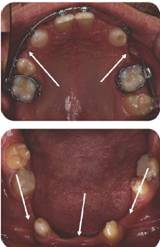
Management of ectodermal dysplasia III—a multidisciplinary approach
The ectodermal dysplasias (EDs) are inherited disorders of the embryonic ectoderm. These abnormalities of ectodermal derived structures can affect teeth, nails, skin, hair and sweat glands. The management of adults with ectodermal dysplasia who have not been adequately treated in childhood may present with complex oral presentation and may require multidisciplinary treatment approaches. Long-standing abnormal growth of the maxilla and mandible with an insufficient number of remaining teeth often has a psychological impact on the patient.
CASE STORY
A 25-year-old male presents to the clinic with the chief complaint of “I was born without many teeth. I need to eat and want to be healthy.” The patient used to wear a removable partial denture during childhood until the age of 12.
Figure 1: Preprosthetic treatment maximum intercuspation (MI).

Figures 2 and 3: Preprosthetic treatment left and MI right.


LEARNING GOALS AND OBJECTIVES
- Identify the consequences of untreated ectodermal dysplasia.
- Discuss the importance of diagnostic mock-up procedures to assess the degree of an underdeveloped maxilla and mandible.
- Understand the determining factors in assessing desired vertical dimension of occlusion.
- Understand the determining factors affecting the facial profile.
Medical History
- History of tonsillectomy at age 10
- Hypohidrotic ectodermal dysplasia
Dental History
- Removable partial denture (RPD) during childhood, discontinued by age 12
Clinical Findings/Problem List
- Missing teeth
- Excessive loss of vertical dimension
- Insufficient width of maxillary alveolar ridges
- Knife-edge mandibular ridges
- High frenum attachment level
- Concave facial profile
- Insufficient posterior contacts
- Poor crown-to-root ratio at the existing vertical dimension of occlusion (VDO)
- Limited interarch space at the existing VDO
- Midline discrepancy
Clinical and Radiographic Findings
- Root-canal treated mandibular molars
- Large pulps
- Defective existing restorations
- Hypodivergent mandibular plane
- Deficient lower 1/3 of face height
Figure 4: Front view.

Figure 5 and 6: Maxillary and mandibular occlusal views.

Diagnosis
- Ectodermal dysplasia (ED)
- Partial edentualism
- Excessive interocclusal space at the desired (restored) VDO
- Midline discrepancy
Clinical Decision-Making Determining Factors
- The initial determination of optimal desired vertical dimension of occlusion based on the aesthetics and phonetics is essential in ass/>
Stay updated, free dental videos. Join our Telegram channel

VIDEdental - Online dental courses


